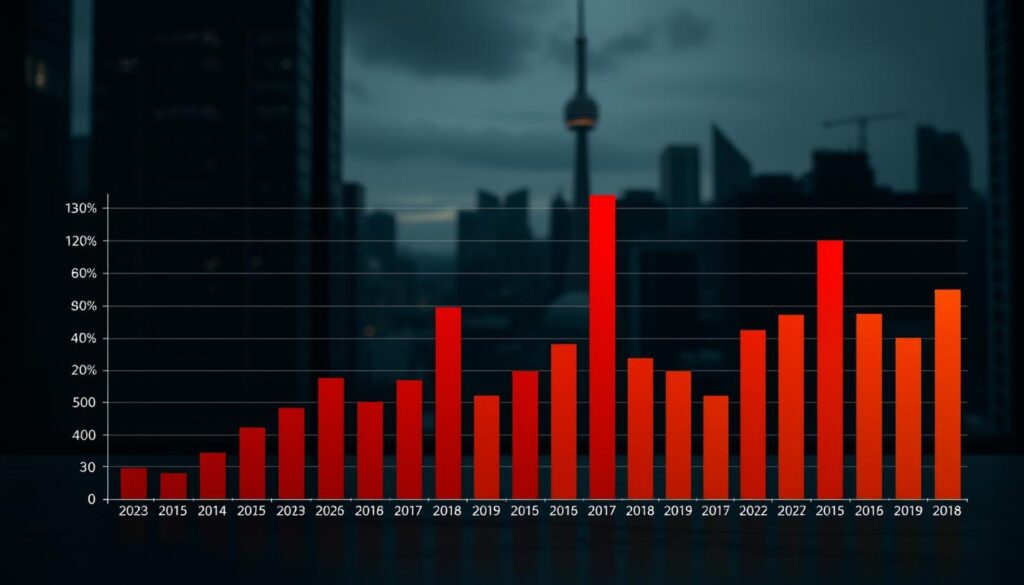Toronto is considered one of the safest major cities globally, with a ranking of 6th safest major city in the world and the safest in North America in 2024, according to The Economist. However, like any city, it faces challenges related to crime. Understanding the crime rate per 100,000 people is crucial for developing effective prevention strategies.
For detailed analysis and statistics on Toronto crime rates, it’s essential to examine the various types of criminal activities and trends. With a crime severity index lower than many other major Canadian cities, Toronto serves as a model for crime prevention.
The city’s safety is a result of combined efforts from law enforcement and community-based programs, making it a significant aspect of preventing crime in Canada.
Current State of Crime in Toronto
Understanding the current state of crime in Toronto is crucial for residents, policymakers, and law enforcement agencies. Toronto, being Canada’s largest city and a significant metropolitan area, faces various crime-related challenges.

Toronto’s Safety Ranking Among Global Cities
Toronto is considered one of the safer major cities globally. While exact global rankings can vary, Toronto’s crime rate is relatively low compared to other major metropolitan areas. The city’s safety profile is influenced by effective urban planning, policing strategies, and social services.
2024 Crime Statistics Overview
The latest crime statistics for Toronto indicate a continued trend of relatively low crime rates compared to other major Canadian cities. In 2024, Toronto reported a homicide rate of 2.26 per 100,000 people, ranking ninth among major Canadian metropolitan regions.
| City | Crime Rate per 100,000 |
|---|---|
| Toronto | 69.2 |
| Winnipeg | 135.8 |
| Edmonton | 113.3 |
| Regina | 117.4 |
Comparison to Other Canadian Cities
When comparing crime rates across Canada, Toronto stands out as having a lower crime rate than many other major cities. Cities like Winnipeg, Edmonton, and Regina experience significantly higher crime rates per 100,000 people. Toronto’s surrounding regions, such as Peel Region, York Region, and Halton Region, also report lower crime rates, contributing to a safe greater metropolitan area.
Understanding Crime Rates Toronto: Historical Trends
Understanding the historical trends in crime rates in Toronto is crucial for grasping the city’s current safety landscape. By examining the fluctuations in crime over time, we can identify patterns and factors that contribute to the city’s overall crime rate.
The “Year of the Gun” and Its Aftermath
In 2018, Toronto was labeled the “Year of the Gun” due to a significant surge in gun-related violence. This period saw a notable increase in homicides and shooting incidents, drawing attention to the city’s growing crime concerns. The aftermath of this surge led to increased efforts by law enforcement to address gun violence and implement strategies to reduce crime.
The impact of the “Year of the Gun” was felt beyond 2018, with subsequent years showing varied trends in crime rates.
Fluctuations in Homicide Rates (2015-Present)
Between 2015 and the present, Toronto has experienced fluctuations in its homicide rates. The data indicates a general increase in homicides during certain years, followed by periods of decline. For instance, the homicide rate increased significantly in the years leading up to 2018, before experiencing some fluctuations in subsequent years.
| Year | Homicide Rate |
|---|---|
| 2015 | 1.6 per 100,000 |
| 2018 | 2.0 per 100,000 |
| 2020 | 1.8 per 100,000 |
Shooting Incidents Trends
Shooting incidents in Toronto have followed a concerning trajectory, with a significant increase observed between 2014 and 2019. The data shows that shooting incidents rose from 177 in 2014 to a peak of 495 in 2019, representing a 179% increase over this five-year period. The shooting rate in 2019 was 18.1 per 100,000 people, which was notably higher than New York City’s rate of 9.1 per 100,000 residents during the same year.

The subsequent years saw a decline in shooting incidents, dropping to 345 in 2023. However, 2024 witnessed a 33.6% increase in shootings, with 461 incidents reported, raising concerns about the sustainability of the previous downward trend.
“The fluctuations in shooting incidents are attributed to various factors, including gang activity and socioeconomic challenges exacerbated by the pandemic.”
Violent Crime Analysis in Toronto
Understanding violent crime in Toronto involves examining the statistics and trends related to different types of violent offenses. Violent crime is a significant concern for the city, impacting the safety and well-being of its residents.
Homicide Statistics and Patterns
Homicide rates in Toronto have shown variability over the years. The number of homicides has fluctuated, with some years seeing significant increases. For instance, gun-related homicides increased from 22 in 2013 to a peak of 51 in 2018. This trend highlights the need for continued efforts to address gun violence.
Assault and Robbery Trends
Assault and robbery are other significant components of violent crime in Toronto. These crimes affect many people and can have a lasting impact on victims and their communities. Analyzing the rate of these crimes over time helps law enforcement and policymakers develop targeted interventions.
Gun-Related Violence
Gun-related violence is a critical aspect of Toronto’s violent crime landscape. The data indicates that gun deaths more than doubled from 22 in 2013 to 51 in 2018. Although there have been fluctuations since then, with 44 gun deaths in 2019, 39 in 2020, 46 in 2021, 44 in 2022, and 29 in 2023, before rising again to 44 in 2024, the trend remains a concern. Key statistics include:
- Approximately 80% of crime guns recovered in Toronto originate from the United States.
- Gang-related conflicts account for about 60% of shootings.
- Shooting incidents are concentrated in specific neighborhoods, with about 40% occurring in just 11% of the city’s geographic area.

Property Crime in Toronto
Property crime in Toronto encompasses a wide range of offenses, including breaking and entering, vehicle theft, and various forms of fraud. The chance of being a victim of property crime in Toronto is 1 in 47, a statistic that underscores the importance of understanding these crimes. For more information on crime rates across Canada, you can explore crime statistics that provide a broader context.
Breaking and Entering Statistics
Breaking and entering is a significant component of property crime in Toronto. Statistics show that this type of crime continues to affect neighborhoods, highlighting the need for vigilance and effective crime prevention strategies. Residents are advised to secure their properties and report any suspicious activities to the authorities.
Vehicle Theft Trends
Vehicle theft is another prevalent property crime in Toronto. Recent trends indicate a steady occurrence of vehicle thefts, often involving modern vehicles with advanced security features being targeted by sophisticated thieves. The Toronto Police Service has been working to combat this issue through various initiatives.
Fraud and Other Property Crimes
Fraud has become increasingly prevalent in Toronto’s property crime landscape. Cybercrime, identity theft, and financial scams have shown consistent year-over-year growth of approximately 15% annually since 2019. Some key trends include:
- The digital transformation of financial services has created new vulnerabilities, with online banking fraud, e-transfer scams, and cryptocurrency-related schemes being the fastest-growing subcategories.
- Senior citizens are disproportionately targeted by certain fraud types, particularly telephone scams impersonating government agencies or family members in distress, with average losses exceeding $10,000 per victim.
- Other significant property crimes include shoplifting, which accounts for approximately 25% of all theft reports, and bicycle theft, which has seen a 30% increase following the expansion of cycling infrastructure.

Toronto’s Crime Clearance Rates
Understanding Toronto’s crime clearance rates is crucial for assessing the effectiveness of its law enforcement strategies. The clearance rate, which indicates the percentage of crimes solved by the police, is a vital metric for evaluating the performance of law enforcement agencies.
Understanding Weighted Clearance Rates
The weighted clearance rate is a statistical measure that takes into account the varying levels of complexity and resources required to solve different types of crimes. In Toronto, the overall clearance rate stands at 34%, slightly below the national average of 37%. For violent crimes, the clearance rate is 52%, compared to the national average of 58%. This indicates that while Toronto’s police service is effective in solving violent crimes, there is still room for improvement.
Comparison to National Averages
When comparing Toronto’s clearance rates to national averages, some disparities become apparent. The clearance rate for property crimes in Toronto is 22%, which is 5 percentage points lower than the national average of 27%. This suggests that Toronto faces unique challenges in addressing property crimes, potentially due to its dense urban environment and high volume of cases.

As noted by a law enforcement expert, “The complexity of policing in a diverse metropolitan area like Toronto presents significant challenges in resolving criminal cases.” Toronto’s clearance rates rank in the middle tier among major Canadian cities, outperforming some like Vancouver but trailing behind others such as Ottawa and Quebec City.
- The overall crime clearance rate in Toronto is 34%, slightly below the national average.
- For violent crimes, Toronto’s clearance rate is 52%, trailing the national average of 58%.
- Property crime clearance rate stands at 22%, compared to the national average of 27%.
Toronto’s crime clearance rates highlight the need for continued improvement in law enforcement strategies, particularly in addressing property crimes and managing the high volume of cases in the city.
Geographical Distribution of Crime in Toronto
Understanding the geographical distribution of crime in Toronto is crucial for identifying areas that require more attention from law enforcement and community safety initiatives. The city’s crime map provides a detailed overview of all crimes reported by the local law enforcement agency, using a color-coded legend to differentiate between areas with lower and higher crime rates.

High-Crime Areas
Certain neighborhoods in Toronto experience higher levels of crime compared to others. While specific areas are not named, the crime map indicates that regions with higher population density and commercial activity tend to have higher crime rates. These high-crime areas often require targeted law enforcement strategies and community programs to reduce criminal activity and improve safety.
- Higher population density and commercial activity are associated with increased crime rates.
- Targeted law enforcement and community initiatives are crucial for reducing crime in these areas.
Safest Neighborhoods
Toronto’s safest neighborhoods include areas such as Forest Hill, Lawrence Park, Bridle Path, Hoggs Hollow, and parts of Etobicoke, which record crime rates 60-80% below the city average. These low-crime areas share common characteristics, including higher property values, lower population density, and strong community engagement in neighborhood watch and safety initiatives.
- Characteristics of safe neighborhoods include higher property values and lower population density.
- Community engagement and neighborhood watch programs play a significant role in maintaining safety.
The Yonge-Eglinton area is a notable example of a safe urban neighborhood despite its density, demonstrating the effectiveness of well-planned urban development in maintaining low crime levels. Even in the safest neighborhoods, property crimes remain a concern, with breaking and entering and vehicle theft being the most common criminal activities.
Organized Crime in Canada
The landscape of organized crime in Canada is complex and multifaceted, involving diverse groups and criminal activities. Organized crime has been a persistent issue, with various groups operating across the country, often with significant impacts on local communities and the broader economy.
Historical Development of Organized Crime
Historically, organized crime in Canada has roots dating back to the early 20th century, with significant activity during the Prohibition era in the United States, which turned cities like Toronto into major centers for bootlegging operations. Italian organized crime, particularly the Calabrian ‘Ndrangheta and the Sicilian Mafia, has remained prevalent. The Siderno Group, for instance, has maintained a significant presence in the Greater Toronto Area.
During Prohibition, Toronto became a hub for bootlegging into the United States, attracting Italian-American organized crime groups, such as the Buffalo crime family. This historical context laid the groundwork for the sophisticated organized crime networks seen today.
Current Organized Crime Groups
Today’s organized crime landscape in Canada features a diverse array of groups operating across multiple criminal markets. The Calabrian ‘Ndrangheta continues to be a significant player, particularly through the Siderno Group in the Greater Toronto Area. Street gangs with international ties have also emerged, controlling specific territories and engaging in drug distribution, weapons trafficking, and human trafficking within urban city centers.
- Asian organized crime groups, including triads and networks connected to mainland China, have established sophisticated operations focusing on synthetic drug production, financial crimes, and money laundering.
- Outlaw motorcycle gangs, such as the Hells Angels, maintain a strong presence across Canada, controlling significant portions of the drug trade and protection rackets.
- The integration of technology has transformed organized crime, with cybercrime, cryptocurrency-based money laundering, and online marketplaces becoming increasingly important.
These groups operate within a population that is diverse and widespread, often leveraging technology to expand their reach and evade law enforcement. The complexity and adaptability of these groups pose significant challenges for law enforcement agencies aiming to combat organized crime.

The Canadian Criminal Code: Understanding Crime Classifications
To comprehend the legal landscape of crime in Canada, it’s essential to examine the classifications outlined in the Canadian Criminal Code. The Code is a comprehensive legal framework that categorizes various offenses, providing a foundation for understanding the country’s legal response to different types of crime.
Major Criminal Offenses
The Canadian Criminal Code classifies offenses into several categories, including violent crimes like assault and homicide, and property crimes such as theft and vandalism. Understanding these classifications is crucial for both legal professionals and the general public. Violent crimes are considered serious offenses and are prosecuted accordingly. Property crimes, while significant, often carry different legal implications.

Recent Changes to the Criminal Code
Recent amendments to the Canadian Criminal Code have focused on modernizing provisions related to assault, particularly sexual assault, by clarifying consent definitions and limiting the use of intoxication as a defense. Bill C-75, implemented in 2019, introduced procedural reforms aimed at reducing court delays. Reforms have also addressed Indigenous overrepresentation in the criminal justice system, promoting restorative justice approaches. Cybercrime provisions have been updated to address emerging threats, including online harassment and non-consensual distribution of intimate images. These changes reflect the evolving nature of crimes over the years.
Law Enforcement Strategies in Toronto
Effective law enforcement in Toronto involves a combination of traditional policing and innovative community approaches. The city has seen a shift towards more integrated and responsive policing strategies.
Toronto Police Service Initiatives
The Toronto Police Service has launched several initiatives aimed at reducing crime and improving community relations. One key program is the Youth in Policing Initiative (YIPI), which provides employment opportunities for young people from priority neighborhoods, fostering positive relationships between youth and police.
The service has also modernized its Neighborhood Watch programs with digital components, including WhatsApp groups and online reporting tools, to enhance community engagement and crime prevention.
Community Policing Approaches
Toronto’s community policing model emphasizes collaborative problem-solving between law enforcement and residents. Community Consultative Committees have been established in each division to provide direct citizen input into policing priorities and strategies.
Cultural liaison officers work with Toronto’s diverse communities, providing culturally sensitive policing services and building trust with immigrant populations. Additionally, the Mobile Crisis Intervention Team pairs police officers with mental health nurses to respond to calls involving individuals in psychological distress.
| Initiative | Description | Impact |
|---|---|---|
| Youth in Policing Initiative (YIPI) | Employment opportunities for youth from priority neighborhoods | Fosters positive youth-police relations |
| Modernized Neighborhood Watch | Digital tools for community engagement and crime reporting | Enhanced community policing |
| Cultural Liaison Officers | Culturally sensitive policing for diverse communities | Builds trust with immigrant populations |

Crime Prevention Programs in Canada
Crime prevention in Canada involves a multi-faceted approach, incorporating federal, provincial, and local programs to enhance community safety and reduce criminal activity.
Federal Crime Prevention Initiatives
The Canadian government has launched several federal crime prevention initiatives. These include programs focused on youth, such as the Youth Crime Prevention Strategy, which aims to prevent youth offending through community-based projects. Additionally, the National Crime Prevention Strategy provides funding for projects that address the root causes of crime.
Provincial Programs in Ontario
In Ontario, provincial programs are in place to support crime prevention. The Ontario government’s Community Safety and Prevention initiatives focus on addressing the root causes of crime, such as poverty and lack of opportunities. Programs like the Ontario Crime Prevention Framework work to reduce crime through evidence-based practices.
Toronto-Specific Prevention Strategies
Toronto has implemented several crime prevention strategies. The Toronto Youth Equity Strategy targets the root causes of youth violence through 28 specific recommendations. Programs like Focus on Youth provide summer employment opportunities in high-needs communities. The FOCUS Toronto initiative brings together multiple agencies to identify and intervene in high-risk situations before they escalate into criminal incidents.
| Program | Focus Area | Objective |
|---|---|---|
| Toronto Youth Equity Strategy | Youth Violence Prevention | Address systemic barriers and provide opportunities for young people |
| Focus on Youth | Summer Employment | Provide positive alternatives for youth during high-risk periods |
| FOCUS Toronto | Multi-Agency Intervention | Identify and intervene in high-risk situations before they escalate |
Public Safety: What Toronto Residents Should Know
Staying safe in Toronto requires a combination of awareness, community engagement, and knowledge of crime prevention strategies. As the city’s residents, it’s essential to understand the dynamics of public safety and how to contribute to it.
Personal Safety Tips
Toronto residents can take several steps to enhance their personal safety. Being aware of one’s surroundings, especially at night, and avoiding walking alone in dimly lit areas can significantly reduce the risk of becoming a victim of crime. People are advised to keep valuables secure and be cautious with strangers.
Additionally, residents should stay informed about local crime trends and report any suspicious activities to the authorities in a timely manner. This proactive approach can help in preventing crimes and ensuring a safer community.
Reporting Crime Effectively
When it comes to reporting crime, Toronto residents have several options. For emergencies requiring immediate police response, calling 911 is the appropriate channel. For non-emergency situations, residents can call the Toronto Police Service’s non-emergency line at 416-808-2222 or use their online reporting system for incidents like theft under $5,000, property damage, or minor traffic accidents.
To report a crime effectively, it’s crucial to provide as much detail as possible, including the exact location, time of the incident, descriptions of suspects or vehicles, and any other relevant information. This helps the police in their investigation and increases the likelihood of a successful resolution. Residents can also report crimes anonymously through Crime Stoppers at 1-800-222-TIPS, which can be particularly useful in cases involving organized crime or when witnesses fear retaliation.
By understanding the appropriate channels for reporting crime and providing detailed information, Toronto residents can play a significant role in maintaining public safety and potentially lowering the crime rate in their neighborhoods.
Conclusion: The Future of Crime Prevention in Toronto
As Toronto continues to evolve, its approach to crime prevention is becoming increasingly sophisticated. The city is adopting more integrated models that combine traditional policing with social services, mental health support, and community development to address the root causes of crime rather than just responding to incidents.
Over time, Toronto’s crime prevention landscape will be shaped by technological innovations, including predictive analytics and artificial intelligence, providing new tools to identify patterns and deploy resources more effectively. For instance, exploring Canada’s violent crime rate in 2024 on canadacrime.ca offers valuable insights into the trends and strategies being implemented.
As the year progresses, demographic shifts, including Toronto’s aging population and continuing immigration patterns, will necessitate adaptations in crime prevention strategies. Addressing socioeconomic inequalities will be crucial, requiring sustained investment in affordable housing, education, and employment opportunities for people in priority neighborhoods, ultimately aiming to lower the rate of crime.

